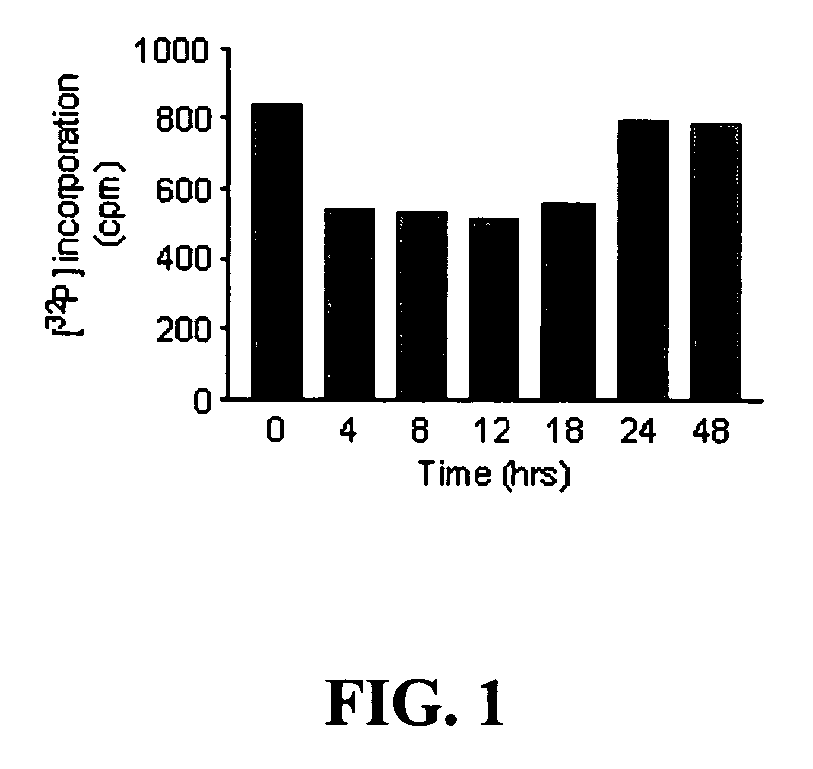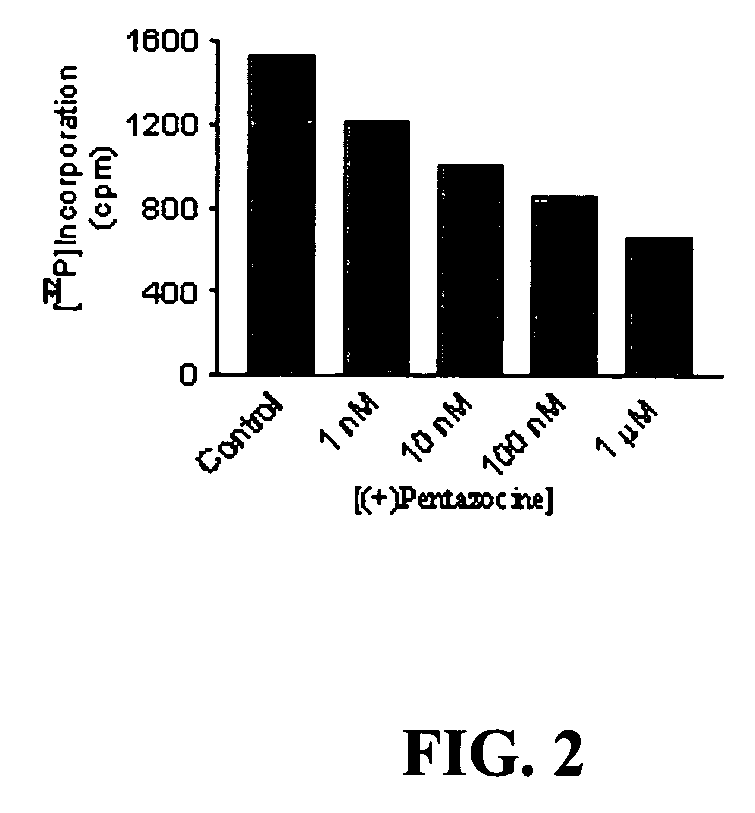Compositions and methods for reversal of drug resistance
- Summary
- Abstract
- Description
- Claims
- Application Information
AI Technical Summary
Benefits of technology
Problems solved by technology
Method used
Image
Examples
example 1
Effect of (+)Pentazocine and Sigma Receptor Ligands on P-Glycoprotein mRNA and Protein Levels in Tumor Cell Lines
[0069] (+)Pentazocine is a sigma-1 receptor ligand shown herein to reduce P-glycoprotein expression at the mRNA and protein levels in tumor cell lines (e.g., neuroblastoma cell lines and ADX cell lines). This example depicts methods that can be used for 1) studying the role of other sigma-1 receptor ligands in producing a similar effect in neuroblastoma cell lines, and 2) studying the similar effects of (+)pentazocine, or other sigma-1 receptor ligands, on various multidrug resistant tumor cell lines ex vivo.
[0070] Tests were performed in a BE(2)--C neuroblastoma cell line. This cell line was used to test the ability of (+)pentazocine to reduce levels of Pgp mRNA and corresponding protein expression in a dose-dependent manner. Pgp levels were tested at the mRNA level by reverse-transcription polymerase chain reaction (RT-PCR) in the presence of .sup.32P-ATP. Incorporation...
example 2
Effect of (+)Pentazocine Treatment on Multidrug-Resistant Cell Lines
[0075] Using the aforementioned drug-resistant cell lines, (+)pentazocine can be assayed for its ability to recapitulate sensitivity to chemotherapeutic agents by measuring 1) cell death and 2) changes in LD.sub.50 values of various chemotherapeutic agents.
[0076] Cytotoxicity can be measured by trypan blue dye exclusion. The initial LD.sub.50 values of the following chemotherapeutic drugs can be determined on parental (sensitive) and resistant cell lines: actinomycin D, doxorubicin, mitoxantrone, vincristine, and paclitaxel. Resistant cells can then be pre-treated with (+)pentazocine, at a concentration previously shown to lower Pgp expression. LD.sub.50 values for the aforementioned drugs after (+)pentazocine treatment can be assessed. Repeated administration of (+)pentazocine may be required to sufficiently maintain Pgp downregulation, and if this is the case, (+)pentazocine dosing schedules can be reassessed esse...
example 3
An In Vivo Mouse Model of Restoring Multidrug Sensitivity with (+)Pentazocine
[0078] All previous examples were performed, or can be performed, ex vivo. An in vivo model can be used to further demonstrate the clinical relevance of (+)pentazocine and other sigma-1 receptor ligands on Pgp inhibition. If the LD.sub.50 values of chemotherapeutic agents outlined in Example 2 are altered after treatment with (+)pentazocine, then the ability of (+)pentazocine to potentiate paclitaxel and doxorubicin-mediated anti-tumor activity can be tested in an in vivo mouse model.
[0079] Human ovarian carcinoma xenografts (described in Plumb et al., 1994. Biochem. Pharmacol. 47(2):257-66) can be performed and implanted into athymic Swiss nude mice at a concentration of 2.times.10.sup.6 cells in 0.1 ml. Parental cells and resistant cells can be injected into the left and right hind flanks of the mice, respectively. The tumor weight (TW) can be determined twice weekly and calculated by the following formul...
PUM
| Property | Measurement | Unit |
|---|---|---|
| Electrical resistance | aaaaa | aaaaa |
| Sensitivity | aaaaa | aaaaa |
| Chemotherapeutic properties | aaaaa | aaaaa |
Abstract
Description
Claims
Application Information
 Login to View More
Login to View More - R&D
- Intellectual Property
- Life Sciences
- Materials
- Tech Scout
- Unparalleled Data Quality
- Higher Quality Content
- 60% Fewer Hallucinations
Browse by: Latest US Patents, China's latest patents, Technical Efficacy Thesaurus, Application Domain, Technology Topic, Popular Technical Reports.
© 2025 PatSnap. All rights reserved.Legal|Privacy policy|Modern Slavery Act Transparency Statement|Sitemap|About US| Contact US: help@patsnap.com



